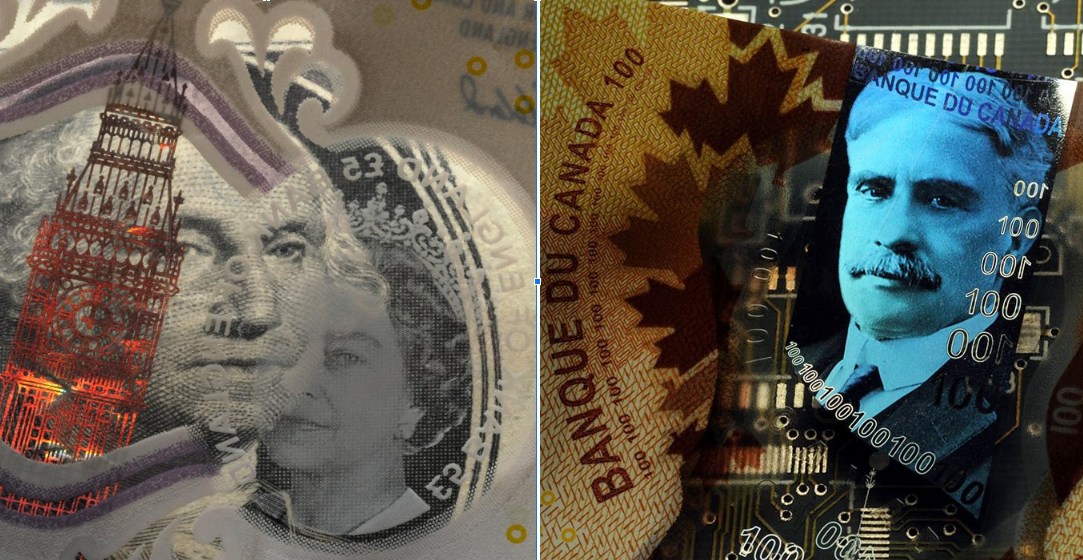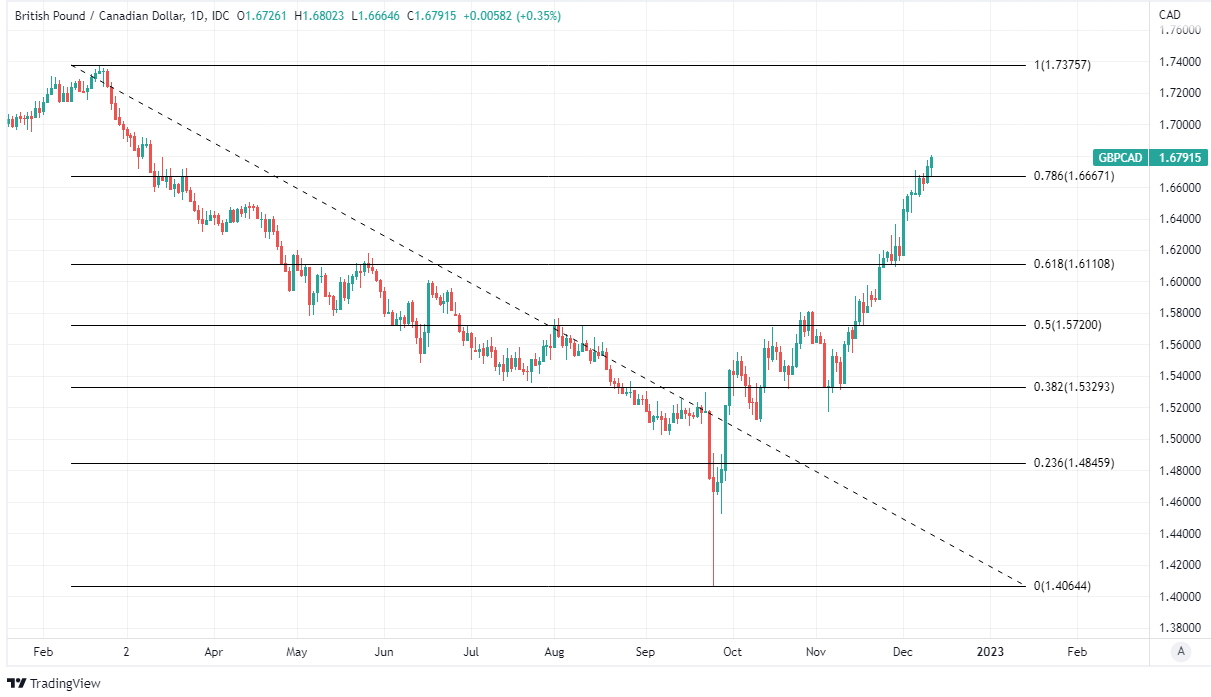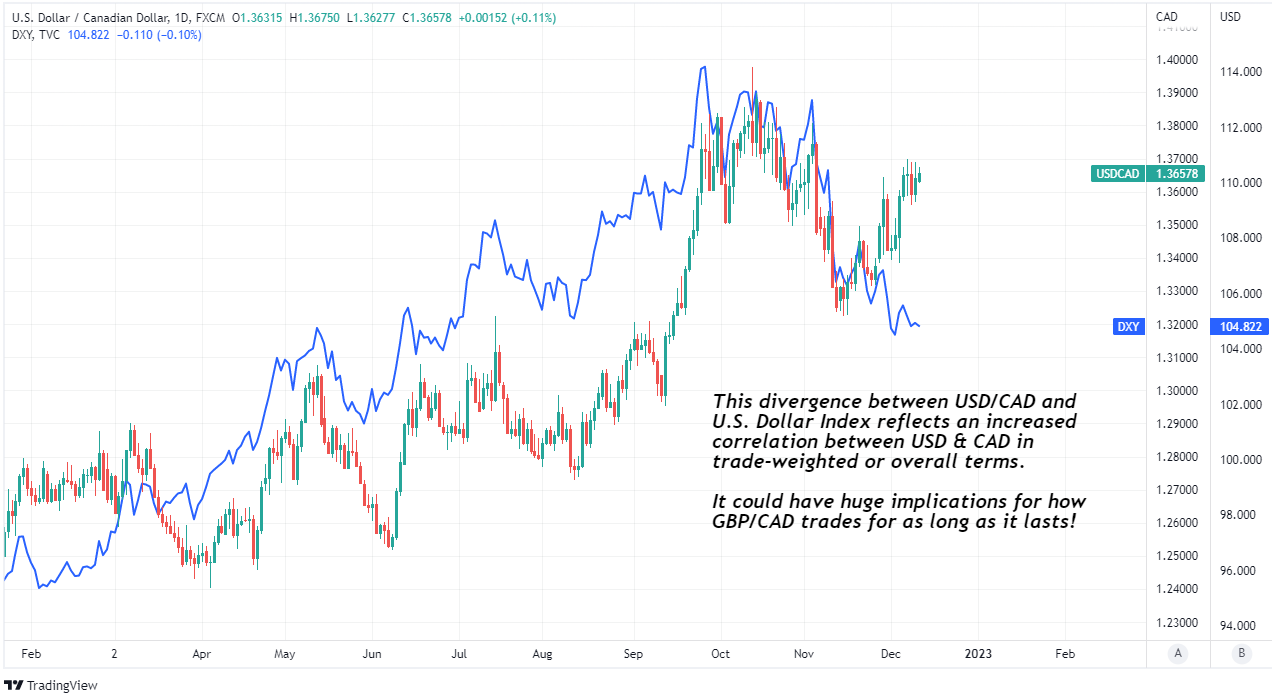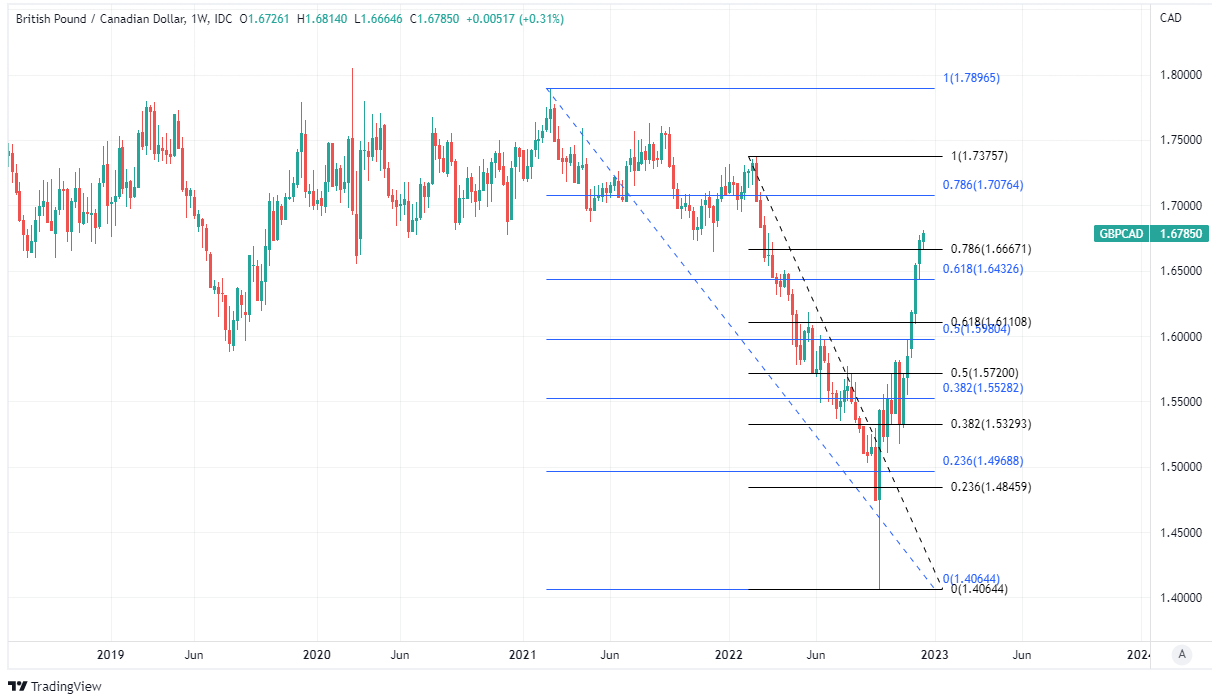GBP/CAD Week Ahead Forecast: Risk of Losses to 1.64 or Below
- Written by: James Skinner
-
- GBP/CAD aims higher but may struggle above 1.69
- High risk of setback & potential foray below 1.6400
- Amid rising trade-weighted CAD & USD correlation
- Implies higher volatility for GBP/CAD in short-term
- U.S. inflaton & Fed in focus ahead of BoE decision

Image © Pound Sterling Live
The Pound to Canadian Dollar exchange rate recovery has gone from strength-to-strength in recent weeks but much of its latest gains are the result of an increased correlation between the trade-weighted Loonie and U.S. Dollar that has placed GBP/CAD at risk of a setback to 1.64 or below this week.
Sterling benefited with other European currencies on Monday when the U.S. Dollar softened and appeared to take other North American currencies like the Canadian Dollar and Mexican Peso with it.
GBP/CAD came close to 1.68 but would risk sharp losses as soon as Tuesday if the latest U.S inflation data goes the wrong way for economists and those parts of the markets taking the view last month that October's data marked a decisive turn in the tide of price pressures.
"Tomorrow’s US November CPI data is so pivotal that it is hard to take a one week view that does not incorporate a view on the impact," says Adam Cole, chief FX strategist at RBC Capital Markets.
"Our bias is positive-USD heading into the report on the view that an upside surprise would drive a bigger market reaction as it would call into question the notion that core inflation has peaked and everything that follows from that," Cole writes in a Monday strategy note sent to clients.
 Above: Pound to Canadian Dollar rate shown at daily intervals with Fibonacci retracements of 2022 decline indicating possible areas of technical resistance for Sterling. Click image for closer inspection.
Above: Pound to Canadian Dollar rate shown at daily intervals with Fibonacci retracements of 2022 decline indicating possible areas of technical resistance for Sterling. Click image for closer inspection.
Cole and RBC colleagues advocated on Monday that clients sell GBP/CAD in anticipation of a fall back to 1.64 this week, which is a target that would be all the more viable in the event of a U.S. Dollar rebound due to the increasingly positive correlation between the trade-weighted U.S. and Canadian Dollars.
"There is little domestic risk in Canada this week and CAD should gain on the crosses if the week’s news is USD positive. Our positioning indicators currently have short CAD as the most extended position in G10, so there is some scope for short-covering into the end of the year," Cole says.
GBP/CAD tends to closely reflect the relative performance of Sterling and the Loonie when each is measured against the U.S. Dollar but has had a negative correlation with the latter throughout much of the last 18 months or so, which has made Sterling increasingly susceptible to strength in the greenback.
That susceptibility has grown further in the last month or so, however, amid an ongoing divergence between USD/CAD and the U.S. Dollar Index that reflects the growing correlation between the trade-weighted Canadian and U.S. Dollars.
"Directionality should come from central bank decisions and the US CPI print this week for the most part – though we’re a bit circumspect on the scale by which the CAD has sold off against the USD," says Bipan Rai, North American head of FX strategy at CIBC Capital Markets.
 Above: USD/CAD shown at 4 hour intervals alongside U.S. Dollar Index. Click image for closer inspection. If you are looking to protect or boost your international payment budget you could consider securing today's rate for use in the future, or set an order for your ideal rate when it is achieved, more information can be found here.
Above: USD/CAD shown at 4 hour intervals alongside U.S. Dollar Index. Click image for closer inspection. If you are looking to protect or boost your international payment budget you could consider securing today's rate for use in the future, or set an order for your ideal rate when it is achieved, more information can be found here.
"CAD undervaluation stretches out to the crosses as well with EUR/CAD and GBP/CAD looking most likely to correct lower in the near-term. For now, we’re happy to stick with a 1.32-1.37 range for USD/CAD," Rai adds.
While the new negative correlation between USD/CAD and the U.S. Dollar Index would potentially see GBP/CAD dropping back to 1.64 or below in the event of any recovery by the greenback this week, it could also see GBP/CAD rise notably further if the recent lower in North American exchange rates persists.
Whether that happens would likely depend in substantial part on what Tuesday's U.S. inflation figures for November imply about the likely peak for the Federal Reserve interest rate once into next year, and what the Fed itself says about that outlook on Wednesday.
"We continue to look for the USD to weaken in the medium term— the top of the Fed tightening cycle is close and markets will soon start to anticipate the cycle peak and—later next year—lower rates," writes Shaun Osborne, chief FX strategist at Scotiabank, in a Friday research briefing.
"The same is true for the Bank of Canada, of course, but the CAD should benefit from a sustained improvement in risk appetite as the Fed cycle transitions. Calendar risk next week is meaningful," he adds.
 Above: Pound to Canadian Dollar rate shown at weekly intervals with Fibonacci retracements of February 2021 and February 2022 declines indicating possible areas of technical resistance for Sterling. Click image for closer inspection. To optimise the timing of international payments you could consider setting a free FX rate alert here.
Above: Pound to Canadian Dollar rate shown at weekly intervals with Fibonacci retracements of February 2021 and February 2022 declines indicating possible areas of technical resistance for Sterling. Click image for closer inspection. To optimise the timing of international payments you could consider setting a free FX rate alert here.
Tuesday's inflation data and Wednesday's Fed decision are the highlighs of the week for North American currencies but Sterling and GBP/CAD will also have to navigate a litany of risks in the UK calendar including employment figures out on Tuesday and November's inflation data on Wednesday.
These will set the stage for what is widely expected to be the ninth interest rate rise from the Bank of England (BoE) since last December, which economists and financial markets expect will take Bank Rate up to 3.5% and its highest level since before the 2008 financial crisis.
Those data will follow in the wake of Office for National Statistics (ONS) figures released on Monday suggesting that UK GDP rose by the 0.5% in October, reversing much of the 0.6% decrease from September while surprising on the upside of an economist consensus that had looked for a 0.4% increase.
"We expect the BoE will note that market pricing for the peak in the Bank rate still remains too high. The degree to which markets take heed of the BoE’s warning will influence how far (or not) GBP falls," says Kristina Clifton, a senior economist and currency strategist at Commonwealth Bank of Australia.
"UK economic activity has slowed over the year and it is likely the UK is in recession. UK GDP contracted by 0.2% in Q3 22. We expect further contractions in Q4 22 and in H1 2023. The monthly GDP readings can be volatile," Clifton adds in Monday market commentary.











